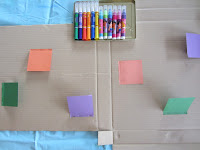In order to encourage my daughter to experiment with the way she draws, I set out a simple little drawing activity as an "Invitation to Draw."
This little set-up encouraged creativity, understanding of shapes, thinking skills, fine motor, coordination, building and more.
Ages: 2+
(see handy tips at the bottom to simplify or extend to meet your child's needs)
Materials: Paper, Markers (we've used the Micador Mega Markers here) and blocks.
When she saw the Invitation to Draw she asked me what she was supposed to do.
I said, whatever you like.
So, she started to trace.
She started to use the shapes of the blocks as inspiration for real life objects of a similar shape.
When she traced the circle she just had to make it a face.
She used the blocks to build her ideas and then trace
(she asked for a triangle block to be added so she could make this house)
A long rectangular block reminded her of a mobile phone.
The great thing about an Invitation to Draw is that the children can still take the activity in the direction they want. Some children may ignore the blocks, some may use the colours or shapes as inspiration, some may try and draw what they see, some might want to build with the blocks, some might trace with them, some may do all or none of those things... they are only limited by their own imagination and creativity. What you are providing them, is a focal point of inspiration and how they use that will depend on the child.
Handy Tips
- Simplify this activity with a few simple basic shapes sitting on the page to encourage their use within the drawing.
- Extend this activity by using the opportunity to talk about 2 dimensional and 3 dimensional shapes. What they see in front of them are 3D shapes and what they are drawing on the paper, is 2D shapes (unless they're really good at drawing!)
- Developing creative thinking can take some time depending on the child. Some children may look at the blocks and have no idea as to how they could be incorporated in their drawing. You could help the child by asking them questions about what the blocks remind them of? What shapes are they? What different colours can they see? etc. You can also just sit down and draw with them. Doing this over time and repeat experiences with a range of materials and opportunities will allow your child the opportunity to experiment and for them to see you "thinking outside the box" and the different ways you use things. They may copy to begin with but they then build upon that with their own ideas and skills.
- Use this opportunity to talk and use varied language with your child to aid in their language development. (eg, "What are you using that cylinder for?" "You have traced around the circular end very well!" "You drew a green rectangle." etc)
- Allow kids to just draw, scribble, doodle, whatever! They don't have to make "something." It does not have to be a picture at the end. Avoid asking, "What is it?" and instead use "What an interesting/great/fabulous/colourful/exciting/dramatic/etc picture! Can you tell me more about it?"
- Here are some more fun ways we like to draw.
(click on the picture to go to the activity)
Happy playing,
Debs :)
Look where else we are. Are you following along? :)
New Here? Subscribe to get all activities sent directly to you











